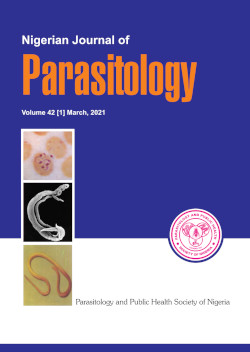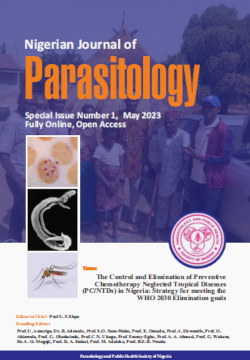Prevalence and Socio-Environmental Factors Associated with Polyparasitism, Benue State, Nigeria
https://dx.doi.org/10.4314/njpar.v42i1.24
Keywords:
Prevalence, helminths, polyparasitism, sanitation, Benue StateAbstract
Parasitic diseases are closely related to poor sanitation, lack of good drinking water, improper disposal of human waste, lack of latrines and poor personal hygiene. This study evaluated the prevalence and distribution of polyparasitic infections and the impact of health education and treatment. Stool and urine samples from 350 consented participants were parasitologically examined for parasites. Out of the 350 samples, 150 stool samples were infected with intestinal parasites and 2 urine samples were positive for Trichomonas vaginalis. Out of the infected 152 participants, 40 of them had co-infection (polyparasitism), specifically 5(1.43%) had triple co-infection, 35(10%) had double co-infection.Health education and treatment measures had significant (p<0.05) effect on infections. It is important that health education be intensified in areas where treatment may not be forthcoming to reduce infections.
References
Warunee, N., Choomanee, L., Sataporn, P., Rapeeporn Y., Nuttapong, W., Sompong, S., Thongdee, S., Bang-On, S and Rachada, K. ( 2007). Intestinal parasitic infections among school children in Thailand. Trop. Biomed 24(2): 83-86
WHO, (2000). World Health Report Conquering Suffering Enriching Humanity. World Health Organization, Geneva.
Scolari,C., Torti,, C., Beltrame,A., Matteelli, A., Castelli, F., Gulletta, M., Ribas, M., Morana, S and Urbani, C., (2000). Prevalence and distribution of SoilTransmitted Helminth infections in urban and indigenous schoolchildren in Ortigueira, State of Parana, Brasil: Implications for control. Trop. Med. Int. Health, 5: 302-307.
Nasiri, V., Esmailian, K., Karim, G., Nasir, M. and Akhavan, O. (2009). Intestinal parasitic infections among inhabitants of Karaj city, Tehran province, Iran in 2006- 2008. Korean J. Parasitol., 47: 265-268.
Raso G, Luginbühl A, Adjoua CA, et al, (2004). Multiple parasite infections and their relationship to self-reported morbidity in a community of rural Côte d’Ivoire. Int J Epidemiol. 33:1092–102.
WHO (World Health Organization) (2002). Prevention and Control of Schistosomiasis and Soil-Transmitted Helminthiasis. WHO Technical Series Report 912.Geneva: WHO.
Mehraj V, Hatcher J, Akhtar S, Rafique G, Beg MA, (2008). Prevalence and Factors Associated with Intestinal Parasitic Infection among Children in an Urban Slum of Karachi. PLoS ONE 3(11): e3680.
Drake LJ, Bundy DA,(2001). Multiple helminth infections in children: impact and control. Parasitol 122 (Suppl): S73–S81.
Tchuente LA, Behnke JM, Gilbert FS, Southgate VR, Vercruysse J, (2003). Polyparasitism With Schistosoma haematobium and soil-transmitted helminth infections among school children in Loum, Cameroon. Trop Med Int Health 8: 975–986.
Arora D.R and Briji B.A (2010 ). Medical Parasitology (3rd edition); CBS Publishers and Distributors PVT Limited, New Delhi, India. p.235-237.
WHO(1991). Sedimentation method in basic L a b o r a t o r y m e t h o d s i n m e d i c a l parasitology, Geneva, pp. 33-35
Akor, J.O, Omudu, E. A,Obisike, V. U. and Imandeh, G.N. (2019).The Prevalence Of PolyparasitismIn Oju, Local Government Area of Benue State, Nigeria. International Journal of Tropical Disease and Health. 39(2)1-6
Akor, J.O, Omudu, E. A, Obisike, V. U., Imandeh, G. N. and Alaku, I. A. (2019) Prevalence and risk factors associated with polyparasitism in Okpokwu Benue State, Nigeria. Journal of Applied Life Science International. 22 (3)1-7
Al-Delaimy AK, Al-Mekhlafi HM, Nasr NA, Sady H, Atroosh WM, Nashiry M, et al. (2014). Epidemiology of Intestinal Polyparasitism among Orang Asli School Children in Rural Malaysia. PLoS Negl Trop D i s 8 ( 8 ) : e 3 0 7 4 . https://doi.org/10.1371/journal/pntd/ 0003074
Ani, O.C and Itiba, O.L, (2015).Evaluation of parasitic contamination from local sources of drinking-water in Abakaliki, Ebonyi State, Nigeria. Nigerian Journal of Parasitology, vol.36 (2) pp153-158.
Downloads
Published
How to Cite
Issue
Section
License
Copyright (c) 2023 Nigerian Journal of Parasitology

This work is licensed under a Creative Commons Attribution-NonCommercial-NoDerivatives 4.0 International License.





